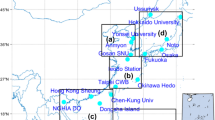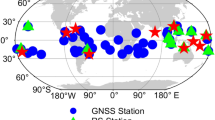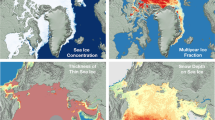Abstract
Sensing precipitable water vapor (PWV) in the earth’s atmosphere is of significant importance for contributing to severe weather event monitoring and forecasting. PWV can be measured and retrieved with various techniques of different accuracies and spatial and temporal resolutions. In this study, we aim to achieve PWV estimates of high accuracy and resolutions by fusing the moderate resolution imaging spectroradiometer (MODIS) and the fifth generation of the European Centre for Medium-Range Forecasts (ECMWF) global reanalyzes (ERA5) with convolutional neural network (CNN). The region is focused on the west coast of America, and the experimental duration lasts for three years, from 2019 to 2021. The fused PWV values reveal a good agreement with the global navigation satellite system (GNSS) PWV, showing a mean absolute error (MAE) of 0.9 mm and a root mean square error (RMSE) of 1.3 mm. The fused PWV demonstrates significant improvement in accuracy compared to MODIS PWV estimates, with the MAE and RMSE reduced by 75.3% and 72.4%. Meanwhile, they also outperform the ERA5 PWV, revealing decreases of 34.6% in RMSE and 35.2% in MAE, respectively. Besides, the multilayer perceptron algorithm is also applied in PWV fusion as a comparison, which reveals a worse performance than the CNN fusion model. Furthermore, the fused PWV is less affected by seasonal variations and can provide more detailed spatial features compared to MODIS and ERA5 PWV. The proposed approach contributes to exploiting the full potential of MODIS and ERA5 products and offers promising potential for meteorological applications.








Similar content being viewed by others
Data availability
The GNSS PWV data used in this study can be accessed at https://www.suominet.ucar.edu/data/. The MODIS PWV data can be accessed at https://ladsweb.modaps.eosdis.nasa.gov/search/order. The ECMWF ERA5 PWV data can be accessed at https://cds.climate.copernicus.eu/. The SRTM topography data are available from https://srtm.csi.cgiar.org/srtmdata/.
References
Alshawaf F, Fuhrmann T, Knöpfler A, Luo X, Mayer M, Hinz S, Heck B (2015a) Accurate estimation of atmospheric water vapor using GNSS observations and surface meteorological data. IEEE Trans Geosci Remote Sens 53(7):3764–3771. https://doi.org/10.1109/TGRS.2014.2382713
Alshawaf F, Fersch B, Hinz S, Kunstmann H, Mayer M, Meyer F (2015b) Water vapor mapping by fusing InSAR and GNSS remote sensing data and atmospheric simulations. Hydrol Earth Syst Sci 19(12):4747–4764. https://doi.org/10.5194/hess-19-4747-2015
Bevis M, Businger S, Herring TA, Rocken C, Anthes RA, Ware RH (1992) GPS meteorology: remote sensing of atmospheric water vapor using the global positioning system. J Geophys Res Atmos 97(D14):15787–15801. https://doi.org/10.1029/92JD01517
Bevis M, Businger S, Chiswell S, Herring TA, Anthes RA, Rocken C, Ware RH (1994) GPS meteorology: mapping zenith wet delays onto precipitable water. J Appl Meteorol 1988–2005:379–386. https://doi.org/10.1175/1520-0450(1994)033%3c0379:GMMZWD%3e2.0.CO;2
Chen F-C, Jahanshahi MR (2017) NB-CNN: deep learning-based crack detection using convolutional neural network and Naïve Bayes data fusion. IEEE Trans Ind Electron 65(5):4392–4400. https://doi.org/10.1109/TIE.2017.2764844
Chen B, Yu W, Wang W, Zhang Z, Dai W (2021) A global assessment of precipitable water vapor derived from gnss zenith tropospheric delays with ERA5, NCEP FNL, and NCEP GFS products. Earth Space Sci 8(8):e2021EA001796. https://doi.org/10.1029/2021EA001796
Di L, McDonald KR (2006) The NASA HDF-EOS Web GIS Software Suite. In: Qu JJ, Gao W, Kafatos M, Murphy RE, Salomonson VV (eds) Earth Science Satellite Remote Sensing: Data, Computational Processing, and Tools. Springer, Berlin, 2:245–253
Dodson A, Chen W, Penna N, Baker H (2001) GPS estimation of atmospheric water vapour from a moving platform. J Atmos Solar Terr Phys 63(12):1331–1341. https://doi.org/10.1016/S1364-6826(00)00251-0
Duan J, Bevis M, Fang P, Bock Y, Chiswell S, Businger S, Rocken C, Solheim F, van Hove T, Ware R (1996) GPS meteorology: direct estimation of the absolute value of precipitable water. J Appl Meteorol Climatol 35(6):830–838. https://doi.org/10.1175/1520-0450(1996)035%3C0830:GMDEOT%3E2.0.CO;2
Gao B, Kaufman Y, Tanre D (2005) SAFARI 2000 MODIS MOD05_L2 water vapor data, binary format, for Southern Africa. ORNL DAAC. https://doi.org/10.3334/ORNLDAAC/812
Gao J, Li P, Chen Z, Zhang J (2020) A survey on deep learning for multimodal data fusion. Neural Comput 32(5):829–864. https://doi.org/10.1162/neco_a_01273
Gao B-C, Kaufman YJ (1998) The MODIS near-IR water vapor algorithm. Algorithm Theoretical Basis Document, ATBD-MOD 5
Gui K, Che H, Chen Q, Zeng Z, Liu H, Wang Y, Zheng Y, Sun T, Liao T, Wang H (2017) Evaluation of radiosonde, MODIS-NIR-Clear, and AERONET precipitable water vapor using IGS ground-based GPS measurements over China. Atmos Res 197:461–473. https://doi.org/10.1016/j.atmosres.2017.07.021
He J, Liu Z (2019) Comparison of satellite-derived precipitable water vapor through near-infrared remote sensing channels. IEEE Trans Geosci Remote Sens 57(12):10252–10262. https://doi.org/10.1109/TGRS.2019.2932847
Jiang P, Ye S, Chen D, Liu Y, Xia P (2016) Retrieving precipitable water vapor data using GPS zenith delays and global reanalysis data in China. Remote Sens 8(5):389. https://doi.org/10.3390/rs8050389
King MD, Menzel WP, Kaufman YJ, Tanré D, Gao B-C, Platnick S, Ackerman SA, Remer LA, Pincus R, Hubanks PA (2003) Cloud and aerosol properties, precipitable water, and profiles of temperature and water vapor from MODIS. IEEE Trans Geosci Remote Sens 41(2):442–458. https://doi.org/10.1109/TGRS.2002.808226
Kingma D P, Ba J (2014) Adam: a method for stochastic optimization. arXiv preprint arXiv:1412.6980. https://doi.org/10.48550/arXiv.1412.6980
Leckner B (1978) The spectral distribution of solar radiation at the earth’s surface—elements of a model. Sol Energy 20(2):143–150. https://doi.org/10.1016/0038-092X(78)90187-1
Li X, Long D (2020) An improvement in accuracy and spatiotemporal continuity of the MODIS precipitable water vapor product based on a data fusion approach. Remote Sens Environ 248:111966. https://doi.org/10.1016/j.rse.2020.111966
Li Z, Muller JP, Cross P (2003) Comparison of precipitable water vapor derived from radiosonde, GPS, and moderate-resolution imaging Spectroradiometer measurements. J Geophys Res Atmos. https://doi.org/10.1029/2003JD003372
Li Z, Muller JP, Cross P, Fielding EJ (2005) Interferometric synthetic aperture radar (InSAR) atmospheric correction: GPS, moderate resolution imaging spectroradiometer (MODIS), and InSAR integration. J Geophys Res Solid Earth. https://doi.org/10.1029/2004JB003446
Li X, Dick G, Lu C, Ge M, Nilsson T, Ning T, Wickert J, Schuh H (2015) Multi-GNSS meteorology: real-time retrieving of atmospheric water vapor from BeiDou, Galileo, GLONASS, and GPS observations. IEEE Trans Geosci Remote Sens 53(12):6385–6393. https://doi.org/10.1109/TGRS.2015.2438395
Liang H, Cao Y, Wan X, Xu Z, Wang H, Hu H (2015) Meteorological applications of precipitable water vapor measurements retrieved by the national GNSS network of China. Geodesy Geodyn 6(2):135–142. https://doi.org/10.1016/j.geog.2015.03.001
Liu J, Li T, Xie P, Du S, Teng F, Yang X (2020) Urban big data fusion based on deep learning: an overview. Inform Fusion 53:123–133. https://doi.org/10.1016/j.inffus.2019.06.016
Lu C, Li X, Nilsson T, Ning T, Heinkelmann R, Ge M, Glaser S, Schuh H (2015) Real-time retrieval of precipitable water vapor from GPS and BeiDou observations. J Geodesy 89(9):843–856. https://doi.org/10.1007/s00190-015-0818-0
Neiman PJ, Ralph FM, Wick GA, Lundquist JD, Dettinger MD (2008) Meteorological characteristics and overland precipitation impacts of atmospheric rivers affecting the West Coast of North America based on eight years of SSM/I satellite observations. J Hydrometeorol 9(1):22–47. https://doi.org/10.1175/2007JHM855.1
Niell A, Coster A, Solheim F, Mendes V, Toor P, Langley R, Upham C (2001) Comparison of measurements of atmospheric wet delay by radiosonde, water vapor radiometer, GPS, and VLBI. J Atmos Oceanic Tech 18(6):830–850. https://doi.org/10.1175/1520-0426(2001)018%3c0830:COMOAW%3e2.0.CO;2
Patro S, Sahu K K (2015) Normalization: a preprocessing stage. arXiv preprint arXiv:1503.06462. https://doi.org/10.48550/arXiv.1503.06462
Platnick S, Meyer KG, King MD, Wind G, Amarasinghe N, Marchant B, Arnold GT, Zhang Z, Hubanks PA, Holz RE (2016) The MODIS cloud optical and microphysical products: collection 6 updates and examples from Terra and Aqua. IEEE Trans Geosci Remote Sens 55(1):502–525. https://doi.org/10.1109/TGRS.2016.2610522
Prasad AK, Singh RP (2009) Validation of MODIS Terra, AIRS, NCEP/DOE AMIP-II Reanalysis-2, and AERONET Sun photometer derived integrated precipitable water vapor using ground-based GPS receivers over India. J Geophys Res Atmos. https://doi.org/10.1029/2008JD011230
Pukelsheim F (1994) The three sigma rule. Am Stat 48(2):88–91. https://doi.org/10.1080/00031305.1994.10476030
Rabus B, Eineder M, Roth A, Bamler R (2003) The shuttle radar topography mission—a new class of digital elevation models acquired by spaceborne radar. ISPRS J Photogramm Remote Sens 57(4):241–262. https://doi.org/10.1016/S0924-2716(02)00124-7
Rocken C, Ware R, Van Hove T, Solheim F, Alber C, Johnson J, Bevis M, Businger S (1993) Sensing atmospheric water vapor with the global positioning system. Geophys Res Lett 20(23):2631–2634. https://doi.org/10.1029/93GL02935
Rocken C, Anthes R, Exner M, Hunt D, Sokolovskiy S, Ware R, Gorbunov M, Schreiner W, Feng D, Herman B (1997) Analysis and validation of GPS/MET data in the neutral atmosphere. J Geophys Res Atmos 102(D25):29849–29866. https://doi.org/10.1029/97JD02400
Rodriguez E, Morris CS, Belz JE (2006) A global assessment of the SRTM performance. Photogramm Eng Remote Sens 72(3):249–260. https://doi.org/10.14358/PERS.72.3.249
Roman J, Knuteson R, August T, Hultberg T, Ackerman S, Revercomb H (2016) A global assessment of NASA AIRS v6 and EUMETSAT IASI v6 precipitable water vapor using ground-based GPS SuomiNet stations. J Geophys Res Atmos 121(15):8925–8948. https://doi.org/10.1002/2016JD024806
Rukundo O, Cao H (2012) Nearest neighbor value interpolation. arXiv preprint arXiv:1211.1768. https://arxiv.org/pdf/1211.1768.pdf
Shi X, Chen Z, Wang H, Yeung D-Y, Wong W-K, Woo W-C (2015) Convolutional LSTM network: a machine learning approach for precipitation nowcasting. Adv Neural Inform Process Syst. https://doi.org/10.48550/arXiv.1506.04214
Soden BJ, Lanzante JR (1996) An assessment of satellite and radiosonde climatologies of upper-tropospheric water vapor. J Clim 9(6):1235–1250. https://doi.org/10.1175/1520-0442(1996)009%3c1235:AAOSAR%3e2.0.CO;2
Ssenyunzi RC, Oruru B, D’ujanga F M, Realini E, Barindelli S, Tagliaferro G, von Engeln A, van de Giesen N, (2020) Performance of ERA5 data in retrieving precipitable water vapour over East African tropical region. Adv Space Res 65(8):1877–1893. https://doi.org/10.1016/j.asr.2020.02.003
Teke K, Nilsson T, Böhm J, Hobiger T, Steigenberger P, García-Espada S, Haas R, Willis P (2013) Troposphere delays from space geodetic techniques, water vapor radiometers, and numerical weather models over a series of continuous VLBI campaigns. J Geodesy 87(10):981–1001. https://doi.org/10.1007/s00190-013-0662-z
Wang X, Zhang K, Wu S, Fan S, Cheng Y (2016) Water vapor-weighted mean temperature and its impact on the determination of precipitable water vapor and its linear trend. J Geophys Res Atmos 121(2):833–852. https://doi.org/10.1002/2015JD024181
Ware RH, Fulker DW, Stein SA, Anderson DN, Avery SK, Clark RD, Droegemeier KK, Kuettner JP, Minster JB, Sorooshian S (2000) SuomiNet: a real-time national GPS network for atmospheric research and education. Bull Am Meteor Soc 81(4):677–694. https://doi.org/10.1175/1520-0477(2000)081%3c0677:SARNGN%3e2.3.CO;2
Wu H, Yang Q, Liu J, Wang G (2020) A spatiotemporal deep fusion model for merging satellite and gauge precipitation in China. J Hydrol. https://doi.org/10.1016/j.jhydrol.2020.124664
Wu Z, Liu Y, Liu Y, Wang J, He X, Xu W, Ge M (2021) Calibrating the haiyang-2A calibration microwave radiometer when the 18.7-GHz band fails. IEEE Trans Geosci Remote Sens 60:1–10. https://doi.org/10.1109/TGRS.2021.3073278
Zhang B, Yao Y (2021) Precipitable water vapor fusion based on a generalized regression neural network. J Geodesy 95(3):1–14. https://doi.org/10.1007/s00190-021-01482-z
Zhang Q, Ye J, Zhang S, Han F (2018) Precipitable water vapor retrieval and analysis by multiple data sources: ground-based GNSS, radio occultation, radiosonde, microwave satellite, and NWP reanalysis data. J Sens. https://doi.org/10.1155/2018/3428303
Zhang B, Yao Y, Xin L, Xu X (2019a) Precipitable water vapor fusion: an approach based on spherical cap harmonic analysis and Helmert variance component estimation. J Geodesy 93(12):2605–2620. https://doi.org/10.1007/s00190-019-01322-1
Zhang H, Yuan Y, Li W, Zhang B (2019b) A real-time precipitable water vapor monitoring system using the national GNSS network of China: method and preliminary results. IEEE J Select Top Appl Earth Observ Remote Sens 12(5):1587–1598. https://doi.org/10.1109/JSTARS.2019.2906950
Zhang W, Zhang H, Liang H, Lou Y, Cai Y, Cao Y, Zhou Y, Liu W (2019c) On the suitability of ERA5 in hourly GPS precipitable water vapor retrieval over China. J Geodesy 93(10):1897–1909. https://doi.org/10.1007/s00190-019-01290-6
Zhang Y, Cai C, Chen B, Dai W (2019d) Consistency evaluation of precipitable water vapor derived from ERA5, ERA-Interim, GNSS, and radiosondes over China. Radio Sci 54(7):561–571. https://doi.org/10.1029/2018RS006789
Zhao Q, Du Z, Yao W, Yao Y (2020) Hybrid precipitable water vapor fusion model in China. J Atmos Solar Terr Phys. https://doi.org/10.1016/j.jastp.2020.105387
Zhao Q, Du Z, Li Z, Yao W, Yao Y (2021) Two-step precipitable water vapor fusion method. IEEE Trans Geosci Remote Sens. https://doi.org/10.1109/TGRS.2021.3120742
Acknowledgements
This study is financially supported by the National Natural Science Foundation of China (No.41974029), the National Key R&D Program of China (2021YFC3000504), and the Fundamental Research Funds for the Central Universities (2042021kf0005). The numerical calculations have been done on the supercomputing system in the Supercomputing Center of Wuhan University. We gratefully acknowledge Suominet for offering the GNSS-derived PWV in America, NASA for supplying the MOD05_L2 products and SRTM topography products, and ECMWF for offering the ERA5 reanalysis PWV products and the supercomputing system in the Supercomputing Center of Wuhan University for offering the experiment platform.
Author information
Authors and Affiliations
Corresponding author
Additional information
Publisher's Note
Springer Nature remains neutral with regard to jurisdictional claims in published maps and institutional affiliations.
Rights and permissions
Springer Nature or its licensor (e.g. a society or other partner) holds exclusive rights to this article under a publishing agreement with the author(s) or other rightsholder(s); author self-archiving of the accepted manuscript version of this article is solely governed by the terms of such publishing agreement and applicable law.
About this article
Cite this article
Lu, C., Zhang, Y., Zheng, Y. et al. Precipitable water vapor fusion of MODIS and ERA5 based on convolutional neural network. GPS Solut 27, 15 (2023). https://doi.org/10.1007/s10291-022-01357-6
Received:
Accepted:
Published:
DOI: https://doi.org/10.1007/s10291-022-01357-6




